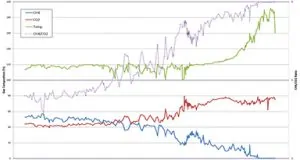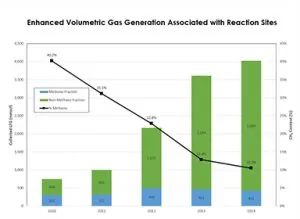


SCS Engineers evaluations of elevated temperature landfills (ETLFs) are backed by years of relevant professional expertise. SCS developed technical standards for the largest waste operator in the U.S. to implement in active and future disposal cells to prevent the formation of ETLF conditions in the landfill. We incorporate these standards into the best management practices (BMPs) of our firm’s landfill management teams across the country.
Our BMPs include a tiered gas well system to collect gas from the entire thickness of waste and to drain landfill liquids reaching the gas well to the bottom leachate collection system. A pressure relief system to remove gas pressure near the bottom lining system to allow unimpeded flow of leachate through the leachate collection drainage layer to the leachate collection pipe. We improve leachate collection pipe/geosynthetics construction preventing clogging of the geotextile wrap around the pipe bedding aggregate, which can potentially impede the flow of leachate to the leachate collection pipe. We design-build interconnecting horizontal gas wells with integrated elements in the tiered gas wells to drain horizontal gas wells to the bottom leachate collection system. Also, SCS’s outward sloping horizontal gas wells separate landfill gas from landfill liquids at the exterior slope of the landfill.
Leachate and condensate management plays a role in identifying and mitigating ETLFs. SCS Engineers professionals work with you through each step of the initial fact-finding process, assuring that your needs and desired outcomes are clearly identified. Then we execute the technical scope of work with your needs and outcomes as the foundation of our work.
SCS’s operation, maintenance & monitoring (OM&M) personnel assist landfill operators with managing their gas fields and monitoring gases from the gas wells at sites with high-temperature conditions. Our professionals can identify the warning signs which usually occur in the collection data but can be difficult to diagnose such as enhanced volumetric gas generation associated with reaction sites.

SCSeTools® is a web-based application platform that collects, monitors, views, charts, graphs, and manages data from more than 670 landfills to help facilities operate more efficiently, continually gauging operational health, spotting trends that help determine when and what to investigate. Landfill staff upload field measurements and monitoring information directly from the field, making the data immediately available for analysis. ETLF related information is stored and managed in the platform that is easily accessible and ready with built-in statistical evaluation techniques.
OM&M teams look for these signs in the field data collected:
Landfill design, configuration, and operation all play a role to mitigate future operational and compliance challenges. Designs can include new engineered features to enhance liquids, gas, and heat removal from the deeper parts of the landfill. Many of the major landfill companies are currently designing and constructing systems to expedite the movement of water and gas through the waste column, which is a great help to potentially minimizing heat accumulations in the landfill.
Relevant Reading: